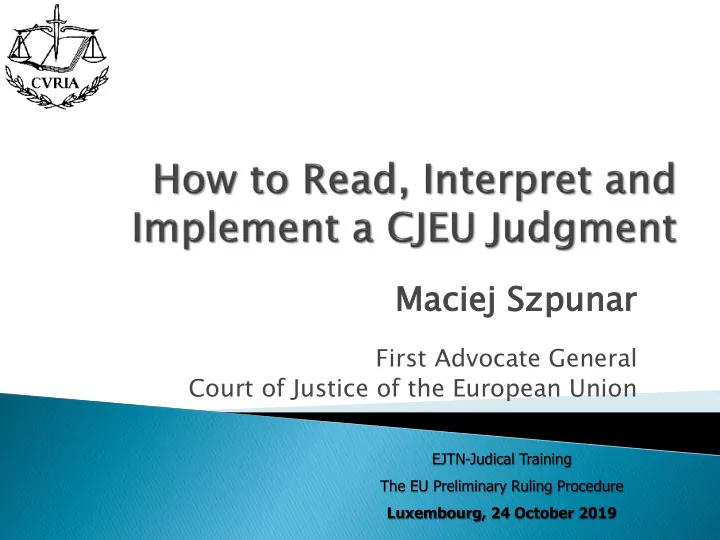

Maciej iej Sz Szpunar punar First Advocate General Court of Justice of the European Union EJTN-Judical Training The EU Preliminary Ruling Procedure Luxembourg, 24 October 2019
Protocol (No 3) [to the TEU and TFEU] on the Statute of the Court of Justice of the European Union ◦ Contains the broad principles regarding judges and Advocates General (AGs), the organisation of the Courts (ECJ and General Court) and the procedure ◦ Article 281 TFEU ◦ Article 51 TEU – The Protocols and Annexes to the Treaties form an integral part thereof 2
Rules of Procedure of the Court of Justice (RP) ◦ Contains ‘any provisions necessary for applying and, where required, supplementing the Statute’, Article 63 Statute ◦ All details regarding procedure ◦ Legal basis: Article 253(6) TFEU ◦ Crucial provision: Article 94 RP – Content of the request for a preliminary ruling 3
2018 ◦ Out of 760 cases completed, 520 were preliminary rulings (68%) 2017 ◦ Out of 699 cases completed, 447 were preliminary rulings (64%) 2016 ◦ Out 704 cases completed, 453 were preliminary rulings (64%) 4
Structure of judgment ◦ Formal part ◦ Legal framework: international law, EU law, national law ◦ Facts in the main proceedings ◦ Question(s) referred ◦ Reply to question(s) ◦ Costs ◦ Operative part 5
6
Formation of the Court ◦ Chamber of 3, 5, 15 (Grand Chamber) or 27 (full Court) judges ◦ Article 16 Statute and Article 60 RP Chamber of 3 or 5 judges: standard Specialised 5 judge chamber for urgent preliminary ruling procedure, Article 11(2) RP Grand Chamber: Difficult or important cases or by explicit request by Member State or EU institution Full court: in cases of ‘exceptional importance’ and dismissal/compulsory retirement/deprivation of office of Ombudsman/Commissioners/members of CoA 7
Reporting judge ◦ Rule: designated by the Court President, Article 15(1) RP ◦ Exception for urgent preliminary ruling procedure (Arts 107 et seq. RP): designated on proposal from Chamber President, Article 15(2) RP Advocate General ◦ Cases are assigned by First AG, Article 16 RP 8
Hearing ◦ Article 23 Statute and Article 76 RP Notification of preliminary questions to Parties of the main proceedings Member States EU Commission EU author of the act the validity or interpretation of which is in dispute (i.e. normally Council and Parliament) Parties and interested persons may submit reasoned request for a hearing 9
Hearing ◦ Article 23 Statute and Article 76 RP No hearing if Court considers, on reading the written pleadings or observations lodged during the written part of the procedure, that it has sufficient information to give a ruling 10
11
Opinion of an Advocate General ◦ Article 20(5) Statute No AG Opinion if case raises no new point of law Language of the case ◦ Article 37(3) RP: the language of the case is the language of the referring court ◦ Not to be confused with the working language of the Court, addressed below 12
Structure of judgment ◦ Formal part ◦ Legal framework: international law, EU law, national law ◦ Facts in the main proceedings ◦ Question(s) referred ◦ Reply to question(s) ◦ Costs ◦ Operative part 13
General legal methods of interpretation ◦ Textual, systematic, historic, teleologic ◦ Article 31 Vienna Convention on the law of Treaties ◦ In the Court’s terminology: spirit, general scheme wording ECJ/267 TFEU specificities ◦ Re-formulation of questions ◦ Inadmissibility of questions ◦ Reporting judge / Advocate General – questions of nationality 14
ECJ/267 TFEU specificities ◦ Wording - Language Principle of multilinguism and linguistic equality Working language of Court: French ◦ Legal concepts can differ in meaning between EU law and national law ◦ Precedent and the Court of Justice ◦ Collegiate nature of judgments ◦ Transnational composition of chambers ◦ No dissenting opinions 15
National judge is judge of EU (law) ◦ ECJ provides interpretation of EU law or (rarely) ruling on validity of secondary EU law ◦ ECJ bound by interpretation of national law done by national judge ◦ National judge hands down judgment and applies law to the facts of the case Degree of scrutiny employed by ECJ varies Example: proportionality test 16
Example 1: C-148/15, Deutsche Parkinson 17
Example 2: C-293/14, Hiebler 18
AG Opinion often helps to grasp the context of a case Effect of judgments ◦ Binding effect inter partes: national judge under direct obligation to implement judgment ◦ Factual erga omnes effect Future reply by reasoned order, Article 99 RP Question is identical to question on which Court has already rules Reply to question may be clearly deduced from existing case-law Answer to the question referred admits of no reasonable doubt 19
Relationship between ECJ and national judge ◦ Initially: horizontal and bilateral ◦ Now: vertical and multilateral ◦ National judge is invited to communicate to the ECJ Registrar the follow-up given to the case on the national level and a copy of the final judgment 20
Texts governing procedure ECJ case-law database National case-law database Lenaerts/Gutiérrez-Fons, To Say What the Law of the EU Is: Methods of Interpretation and the European Court of Justice 21
Recommend
More recommend